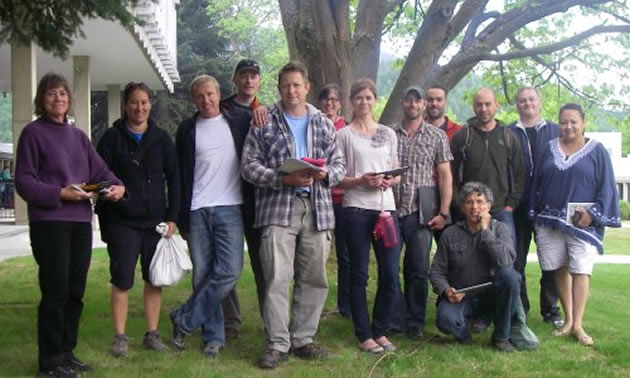Selkirk conference brings digital technologies to the field

Selkirk College workshop leader Jared Hobbs, third from left, and his iPads for GIS group.
Over 30 environmental consultants, researchers, resource practitioners, Selkirk GIS faculty and co-op students attended the New Ways to Use Digital Technologies in the Field conference, held recently at Selkirk’s Castlegar campus.
The conference, co-hosted by Selkirk College and the Columbia Mountain Institute of Applied Ecology in Revelstoke, provided two days of presentations, panel discussions and hands-on demonstrations to explore how technology has changed the way research is done on aquatic, terrestrial and human ecology.
Selkirk College conference participants in the field
Changing the way research is done in the field
More people are taking smartphones, tablets and other devices into the field to increase their productivity, and this conference provided a great opportunity to learn how it all works.
"This was an excellent event for the school's faculty, the participating community and industry professionals,” said School of Environment and Geomatics chair, Brendan Wilson. “The keynote speaker helped set the scene for an interactive, multidisciplinary learning experience that clearly showed how new technology can improve business’s field-based productivity."
Selkirk College conference — Working with iPads to Make Field Work Easier
Hands-on experience
Conference workshops and hands-on outdoor demonstrations focused on using a variety of digital technologies, including iPads and iPhones with specialized apps for making work in the field easier. Participants also tried the Trimble Yuma, a high-tech, durable, outdoor computer used to do specific jobs such as count species and collect data.
“I love that I can use apps on my iPhone, or the Trimble, to work more efficiently in the field,” said forestry consultant, Kirk Daley.
Using digital technologies provides many advantages for practitioners, including spending less time entering data and more time analyzing it, and making fewer errors thanks to embedded drop-down menus and forms.
“Learning new techniques and new software will make field research and GIS more efficient,” said Ezra Buller, a Selkirk GIS co-op student. “The transition from paper to electronics makes our work more seamless.”
Building on strategic directions and inspiring faculty
Co-hosting the conference, and involving college faculty, co-op students and the community, builds on Selkirk's strategic directions to increase enrolments, and engage the wider community in learning and developing innovative programs and services.
“This conference has inspired me to get my students out in the field and integrate digital tools with GIS technology in the areas of forestry, and fish and wildlife,” said Selkirk GIS instructor, Tracey Harvey. “The devices that most students already have at their disposal will positively change how we do our work.”
For more information, please contact the chair of Selkirk’s School of Environment and Geomatics, Brendan Wilson, at 250-365-1393.





Comments